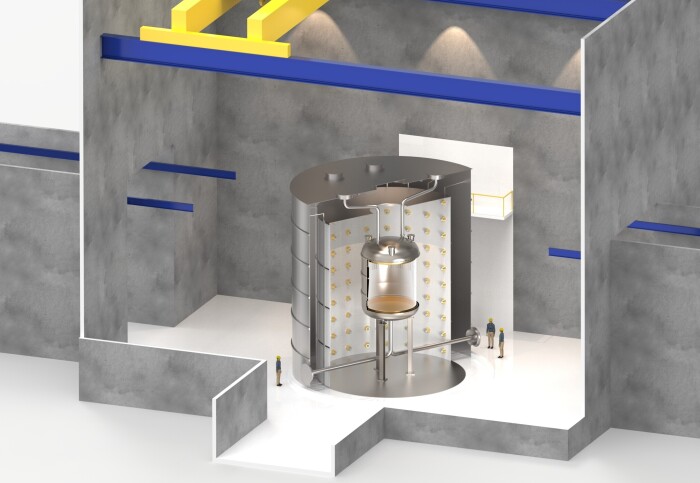Work starts on world’s most sensitive ultra-rare particle detector

Concept for the experiment cavern. Credit: Liam Cooper, STFC Technology Department
UK researchers have begun designing a new device to detect elusive dark matter particles thought to make up 85% of the mass of the Universe.
A preliminary award of £8 million from the UKRI Infrastructure Fund will support a consortium of UK universities, led by Imperial College London, to work with the Science and Technology Facilities Council (STFC) Boulby Underground Laboratory over the next three-and-a-half years.
This development project is critical to position the UK to host the experiment. Professor Henrique Araújo
As part of the world-leading Xenon Lux-Zeplin Darwin (XLZD) Consortium for dark matter research, the team will develop initial plans and design components for the world’s largest and most advanced rare-particle detector, designed to hunt for dark matter candidates and other new physics.
Once completed, this international experiment could be hosted at a new deep underground science facility at Boulby mine in the North East of England.
A new frontier
The XLZD Consortium is the merger of the leading dark matter collaborations: the XENON programme operating at the Laboratori Nazionali del Gran Sasso Italy, the LZ experiment at the Sanford Underground Research Facility in the USA, and the European DARWIN design study.
The Imperial-led team has put forward the case to host the new experiment in the UK, at a major new underground laboratory being developed at the Boulby mine.
A team from STFC has been designing the new facility in collaboration with XLZD scientists and engineers, which would be delivered in two stages: the first at 1,100m depth will contain a clean manufacture facility where XLZD can start construction in 2028, followed by installation of the experiment at a very large new laboratory hall at 1,300m depth in 2030.
The detector will consist of a large underground ‘thermos flask’ containing up to 100 tonnes of liquid xenon, which scientists believe will react subtly with dark matter as it passes through the Earth. Tiny, but detectable, flashes of light will be generated as evidence of the presence of dark matter particles and recorded for scientists to analyse.

The next-generation experiment is ten times larger than the LZ experiment, which is the current world leader. This will allow for a definitive search for the interactions of dark matter particles with masses above a few protons, and also for evidence of particle decays that could help explain why the universe seems to contain ordinary matter but little antimatter, and other rare phenomena that could bring evidence of new physics.
UK project leader Professor Henrique Araújo, from Imperial College London, welcomed the news, saying: “Several underground laboratories around the world are bidding to host our experiment; this is fantastic ‘discovery science’, using the leading technology which we helped pioneer in the UK, and this development project is critical to position the UK to host. We must now show that this is viable!”
Laying the groundwork
Professor Sean Paling, Director and Senior Scientist at STFC’s Boulby Underground Laboratory said: “To discover, or even be able to rule out the existence of dark matter, will be an enormous leap for science and transform our understanding of the cosmos.
“We are now closer than ever to achieving this and as long as we can come together as an international community, invest in the right instruments, and remain focussed on our search, there are potential big breakthroughs just around the corner.
“The XLZD experiment is the clear next step for dark matter research and will also be an important instrument for understanding wider fundamental questions about the content of our universe. I’m delighted that Boulby, Imperial, and all contributing UK institutions are playing this key role in making it a reality.”
Foundational plans
The preliminary funding from the UKRI Infrastructure Fund will be instrumental in devising initial plans for how best to host and run the experiment in the near future and developing essential components required for constructing the detector.
Although it remains to be decided exactly where the experiment will be located, this foundational work by UK universities and Boulby Underground Laboratory will be crucial in deciding how best to build the experiment for success. If the project is hosted at Boulby, this will be amongst the largest and most significant UK-based science projects in over 50 years, attracting international scientists to the North East region.
The project team comprises colleagues from the institutions Birmingham University, Bristol University, Edinburgh University, Imperial College London, King’s College London, Liverpool University, Oxford University, Queen Mary University of London, Royal Holloway University of London, Sheffield University, Sussex University, University College London, and teams from STFC’s Rutherford Appleton Laboratory and from Daresbury Laboratory.
This internationally collaborative effort highlights the UK's strong commitment to advancing scientific research and its capability to contribute significantly to common worldwide scientific endeavours.
Article supporters
Article text (excluding photos or graphics) © Imperial College London.
Photos and graphics subject to third party copyright used with permission or © Imperial College London.
Reporter
Hayley Dunning
Communications Division